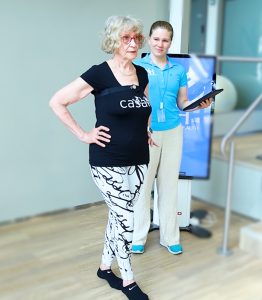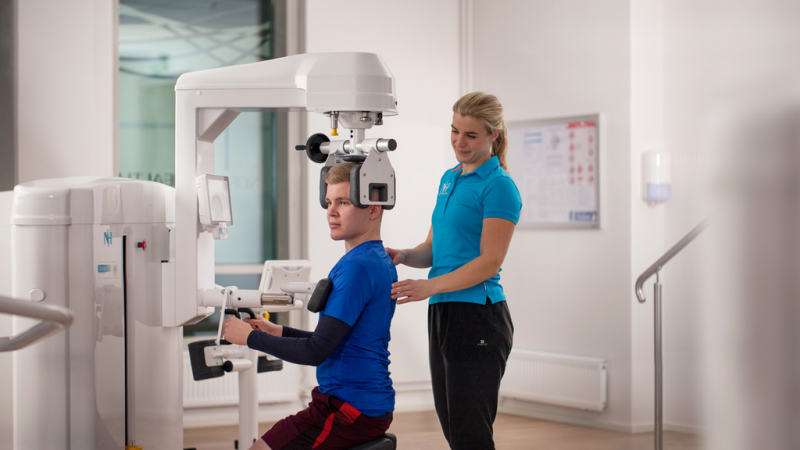The Balance System: A Complex Coordination
Maintaining balance is a complex task that relies on the harmonious coordination of several body systems. At the heart of this process is the central nervous system (CNS), which receives and integrates information from three main sensory systems:
- The Somatosensory System: This system comprises receptors located in the skin, muscles and joints, which detect sensations such as pressure, vibration and body position. It provides the brain with essential information about the position and movement of different parts of the body, which is crucial for adjusting and maintaining balance.
- The Vestibular System: Located in the inner ear, this system detects head movements and orientation in relation to gravity. It plays a key role in stabilizing vision and posture, especially during rapid or sudden movements.
- The Visual System: Sight is also crucial to balance. It provides the brain with information about the external environment, helping to adjust posture and coordinate movements according to the objects and obstacles in our field of vision.
Balancing the Body: A Dynamic Process
Balance is never static. It is based on a dynamic process called ‘body sway’, in which small corrections are constantly made to maintain stability. These adjustments are orchestrated by the central nervous system in response to information provided by the three sensory systems mentioned. For example, when you stand, your body is constantly making micro-adjustments to compensate for involuntary movements and maintain a stable posture.
However, this process is not infallible. An imbalance can occur if one of the sensory systems is compromised or if communication between these systems and the CNS is disrupted. This can happen as a result of a variety of factors, such as age, neurological disease, injury or even a simple lack of fitness.
Balance as an Indicator of Health
Balance is necessary to carry out daily life’s tasks. Moving around, working, playing or simply turning your head requires balance. This requirement applies to everyone, from top athletes to the elderly.
The state of our balance can say a lot about our overall health. Poor balance can reveal underlying problems in various body systems:
- Muscle Strength and Coordination Indicator: Good balance is often synonymous with strong, well-coordinated muscles. If your balance is poor, it may indicate a loss of muscle mass, poor coordination or neurological problems. Elderly people, for example, may find it difficult to maintain their balance due to sarcopenia (age-related loss of muscle mass) or degradation of nerve pathways.
- Mirror of Neurological Health: The central nervous system (CNS) is the orchestra conductor of our balance. Neurological disorders, even minor ones, can alter communication between the sensory systems and the CNS, leading to balance problems. So, a balance problem could be an early sign of more serious conditions, such as Parkinson’s disease, multiple sclerosis or neuropathies.
- Link with cardiovascular health: Studies have shown that people with better balance often have better cardiovascular health. In fact, regular physical activity, which is essential for maintaining balance, is also beneficial for the heart and blood vessels. Balance can therefore indirectly reflect cardiorespiratory capacity and general health.
- Preventing falls and injuries: Balance is particularly important in preventing falls, which are a major cause of injury, especially among the elderly. These injuries can have serious consequences, limiting mobility and quality of life, and often leading to a rapid decline in health.
Screening for fall risk factors
Screening for fall risk factors is essential, especially for the elderly. As we age, the risk of falling increases, due to a variety of intrinsic factors such as physiological changes, and extrinsic factors such as the environment. Regular assessment can identify people at risk, even those who have not yet fallen but feel unsteady when walking. More in-depth monitoring is recommended for those who have already fallen, in order to prevent possible serious injuries and improve their quality of life on a daily basis.
Intrinsic factors are directly linked to the individual and his or her state of health. They include reduced muscle strength, loss of flexibility and slower reflexes, as well as problems with balance and gait. This is why balance and coordination tests are often carried out to assess the risk of falling. Cognitive, visual or auditory problems can also increase this risk, as can taking medication that affects alertness or balance.
Extrinsic factors, on the other hand, are external to the person and relate to their environment. They include factors such as inadequate lighting, slippery floors, lack of handrails on stairs, or obstacles in the way (carpets, electrical cables, etc.). These environmental factors can increase the risk of falling, especially for people who already have intrinsic vulnerabilities.
It is often at the intersection of these two types of factors that falls occur (see graph). A person with balance problems, for example, is more likely to fall if they are in an unsuitable environment, such as a poorly lit or cluttered home. Assessing these two dimensions, intrinsic and extrinsic, will therefore help us to better understand the causes of falls and to put in place targeted preventive measures.
Balance Assessment: A Valuable Tool for Healthcare Professionals
Assessing balance is a crucial step in detecting and treating underlying problems that could affect quality of life.
An accurate balance assessment enables healthcare professionals to identify deficiencies and design appropriate rehabilitation or training programmes. This assessment may include specific tests, where the patient is asked to hold different positions or perform specific tasks, sometimes with eyes closed to isolate the vestibular system and test the CNS response.
The data collected during these assessments may reveal body asymmetries, muscular weaknesses or coordination problems, enabling professionals to adapt their interventions to improve the patient’s balance. For example, as part of musculoskeletal rehabilitation, targeted exercises can be prescribed to strengthen stabilising muscles, improve proprioception and re-establish postural control.
Want to test your balance?

DAVID Balance Powered by Ainone – A Reliable and Precise Balance Measurement Solution
The DAVID Balance concept leverages the Ainone Balance measurement application to deliver quick and straightforward assessments of balance and neurological performance. The system includes the Ainone app, mobile device, and sensor or heart rate monitor for seamless connection. Fully integrated with EVE software, the solution ensures all balance data is securely stored in the patient’s case file.
This application generates numerical values for a quantitative evaluation of body sway parameters, providing objective insights into balance performance. Designed for professionals, the system assesses balance and detects health changes related to balance metrics. The application uses algorithms to measure sway area, length, speed deviations, and records results for analysis.
Improving Balance: The Key to a Long and Healthy Life
Improving balance is achievable at any age and essential for maintaining health and independence. Activities such as yoga, tai chi, or even specific muscle-strengthening and proprioception exercises can greatly improve balance. Regular balance tests help detect changes early, allowing prompt action to prevent serious issues.
Conclusion
In conclusion, balance is not just a question of physical stability; it is a crucial indicator of our overall well-being. Monitoring balance helps prevent falls, detect health issues, and potentially extend life. Cultivating good balance is therefore one of the keys to a longer, healthier and more independent life.
 English
English 
























